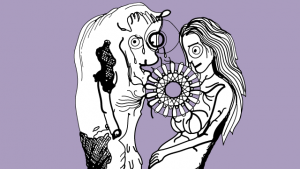At first sight, it would appear that the cannibalistic Fore Tribe of Eastern Papua New Guinea has little in common with a family from the outskirts of Venice. For the most part, this is indeed true, but curiously, both have fallen victim to deadly neurological diseases that have been traced to the same culprit. Until the 1970s, the Fore suffered from devastating epidemics of Kuru, a disease that causes the victim to shake and laugh spontaneously until death. In parallel, in the early 1970s, members of a Venetian family found that by middle age, they were unable to sleep, and died within a few months of exhaustion and dementia from what came to be known as fatal familial insomnia.
Although the symptoms are different, both diseases are caused by the same rogue agent, an infectious protein called the prion. Prions create small holes in the brain, giving it a spongy appearance and thus earning them the name Transmissible Spongiform Encephalopathies (TSEs). TSEs caught the attention of Stanley Prusiner, a young American scientist who began researching scrapie—a form of TSE found in sheep—in 1972. It was first thought that TSEs were caused by a slow-acting virus, however Prusiner could not detect the presence of nucleic acids, the building blocks of viruses, in his scrapie preparations. Instead he found amino acids, the components of proteins.
Prusiner became convinced that TSEs were in fact caused by a protein, which he named the prion, and published his findings in 1982. This caused a furore in the scientific community, sometimes attracting vicious attacks. The concept of an infectious protein was seen as scientific heresy at the time. In the following years, with no viral cause to be found, and an accumulation of research findings supporting the concept of an infectious prion protein, the scientific community slowly began to accept prions as the cause of TSEs. Prusiner’s research would prove to be particularly relevant in light of the bovine spongiform encephalitis (BSE, or more commonly, mad-cow disease) epidemic of the late 1980s and 1990s. In 1997, Prusiner was awarded the Nobel Prize in Physiology or Medicine for his discovery.
Surprisingly prion diseases, unlike bacteria or viruses, can be both contracted bby infection and inherited. It is understood that Kuru must have originated spontaneously from one individual around the 1800s, whose infectious brain was eaten upon his death during cannibalistic funeral rites. When the mode of transmission was uncovered, cannibal practices were halted, and Kuru is now almost non-existent. Fatal familial insomnia, on the other hand, is a rare yet dominant inherited genetic disease that first emerged in the Venetian family, whose members, unfortunately, still suffer from it. Like all prion diseases, Kuru and fatal familial insomnia are incurable.
Another surprising feature of the prion protein is that it is found in healthy individuals at the surface of certain types of cells. The healthy, non-infectious form of the protein is easily soluble, can be digested by enzymes, and is folded into coiled ribbon-shaped structures named alpha helices. Its normal function is yet to be determined, though research suggests it may have a function in long-term memory. In its abnormal and infectious form, the protein has the same composition, yet is insoluble, resistant to enzyme digestion, and is folded into pleated structures called beta sheets. When the infectious prion protein comes into contact with the normal form, it causes it to misfold into beta sheets, thereby converting it into the infectious form. The abnormal form is also heritable, originating from a mutated gene, and which can be passed from generation to generation.
Despite Prusiner’s Nobel Prize, many still doubted the existence of an infectious protein. Sceptics argued that unless infectious material could be generated in-vitro (that is, in the laboratory, outside of the human body) from defined components, the prion hypothesis would remain unconvincing. Over the last three years, this has finally been achieved, demonstrating that the prion is indeed the active component of TSEs. However, many questions remain unanswered; the underlying mechanism of brain degeneration isn’t understood, and it is not possible to rule out the presence of other components involved in prion disease. It would seem that there is much more to learn about these perplexing proteins.
Celia Bell is a Masters student in the Zoology Department.
Art by Kate Pocklington.
![Hereditary Yet Infectious At first sight, it would appear that the cannibalistic Fore Tribe of Eastern Papua New Guinea has little in common with a family from the […]](/wp-content/uploads/2011/10/Hereditary-yet-infectious_preview-620x300.png)
